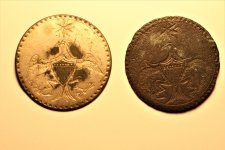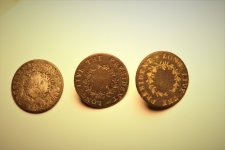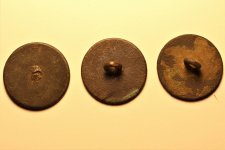tigerbeetle
Full Member
- Jan 2, 2009
- 166
- 275
- Detector(s) used
- Many -- Fisher, White's, Minelab, Cobra, others
- Primary Interest:
- Metal Detecting
Here's a look at my modest George Washington inaugural button finds.
The smaller "Long Live the President" lapel or vest buttons might have come in two plating colors since signs of both gold and silver can be seen. The larger buttons are the same design and show how much better certain soils protect ... or destroy. Hunting formerly farmed fields can show the deleterious effects of fertilizers on coins, damaging copper more than silver.
I found another GW button but sold it, giving into an offer I couldn't resist. It paid for all nine of my metal detectors, ironically, to almost the penny.
All my finds are from South Jersey.
Two of the lapel buttons, found only inches apart, I have been able to trace back to a likely wearer: a gentleman who lived in a homestead within 100 yards of the find point. He was not only close to GW but was personally decorated by him during and after his service. Oddly, his family (namesake) showed very little interest in the buttons when I contacted them. Oh, well, history isn't everyone's bag.
Hunting note: I have hunted heavily forested regions that, per research, were farmlands for sometimes three hundred years. Despite being overgrown, they still show faint signs of oft-furrowed earth. Such former farmlands can sometimes be indicated by stretches of trees of the exact same height and species, often pines. As with modern farmed fields, overgrown fields can contain damaged coins and buttons the victims of centuries of fertilizer. Organic fertilizer, including manure, can be real corrosive stuff.



The smaller "Long Live the President" lapel or vest buttons might have come in two plating colors since signs of both gold and silver can be seen. The larger buttons are the same design and show how much better certain soils protect ... or destroy. Hunting formerly farmed fields can show the deleterious effects of fertilizers on coins, damaging copper more than silver.
I found another GW button but sold it, giving into an offer I couldn't resist. It paid for all nine of my metal detectors, ironically, to almost the penny.
All my finds are from South Jersey.
Two of the lapel buttons, found only inches apart, I have been able to trace back to a likely wearer: a gentleman who lived in a homestead within 100 yards of the find point. He was not only close to GW but was personally decorated by him during and after his service. Oddly, his family (namesake) showed very little interest in the buttons when I contacted them. Oh, well, history isn't everyone's bag.
Hunting note: I have hunted heavily forested regions that, per research, were farmlands for sometimes three hundred years. Despite being overgrown, they still show faint signs of oft-furrowed earth. Such former farmlands can sometimes be indicated by stretches of trees of the exact same height and species, often pines. As with modern farmed fields, overgrown fields can contain damaged coins and buttons the victims of centuries of fertilizer. Organic fertilizer, including manure, can be real corrosive stuff.



Upvote
14






